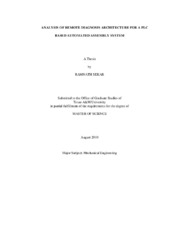| dc.description.abstract | To troubleshoot equipment installed in geographically distant locations, equipment manufacturers and system integrators are increasingly resorting to remote diagnosis in order to reduce the down time of the equipment, thereby achieving savings in cost and time on both the customer and manufacturer side. Remote diagnosis involves the use of communication technologies to perform fault diagnosis of a system located at a site distant to a troubleshooter. In order to achieve remote diagnosis, several frameworks have been proposed incorporating advancements such as automated fault diagnosis, collaborative diagnosis and mobile communication techniques. Standards exist for the capabilities representative of different levels of remote equipment diagnosis. Several studies have been performed to analyze the ability of human machine interface to assist troubleshooters in local fault diagnosis. However, the ability of a remote diagnosis system architecture to assist the troubleshooter in performing diagnosis and the effects of the failure types and other factors in a remote diagnosis environment on remote troubleshooting performance are not frequently addressed. In this thesis, an attempt is made to understand the factors that affect remote troubleshooting performance: remote diagnosis architecture, nature of failure, skill level of the local operator and level of expertise of the remote troubleshooter. For this purpose, three hierarchical levels of remote diagnosis architectures to diagnose failures in a PLC based automated assembly system were built based on existing standards. Common failures in automated assembly systems were identified and duplicated. Experiments were performed in which expert and novice troubleshooters used these remote diagnosis architectures to diagnose different types of failures while working with novice and engineer operators. The results suggest that in the diagnosis of failures related to measured or monitored system variables by remote expert troubleshooters, remote troubleshooting performance improved with the increase in the levels of the remote diagnosis architectures. In contrast, in the diagnosis of these failures by novice troubleshooters, no significant difference was observed among the three architectures in terms of remote troubleshooting performance and the novice troubleshooters experienced problems with managing the increased information available. Failures unrelated to monitored system parameters resulted in significantly reduced remote troubleshooting performance with all the three architectures in comparison to the failures related to monitored system parameters for both expert and novice troubleshooters. The experts exhibited better information gathering capabilities by spending more time per information source and making fewer transitions between information sources while diagnosing failures. The increase in capabilities of the architectures resulted in reduced operator interaction to a to a greater extent with experts. The difference in terms of overall remote troubleshooting performance between engineer and novice operators was not found to be significant. | en |


